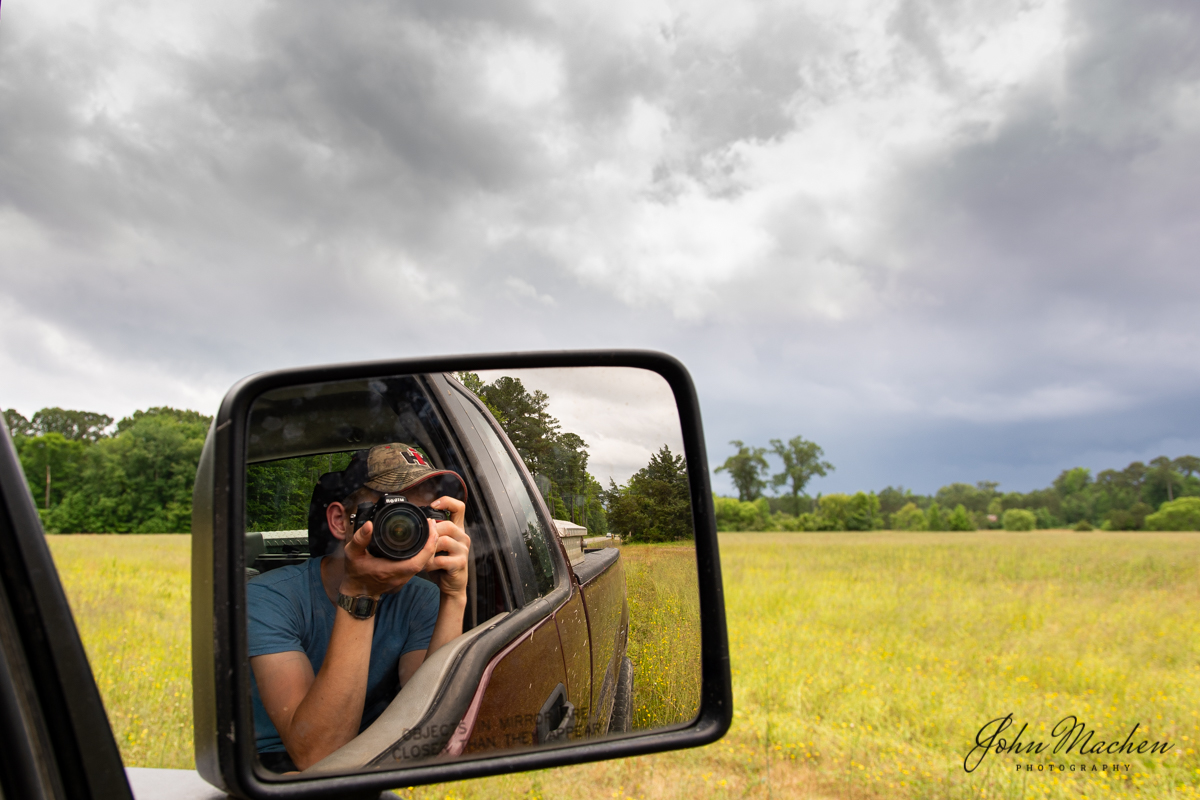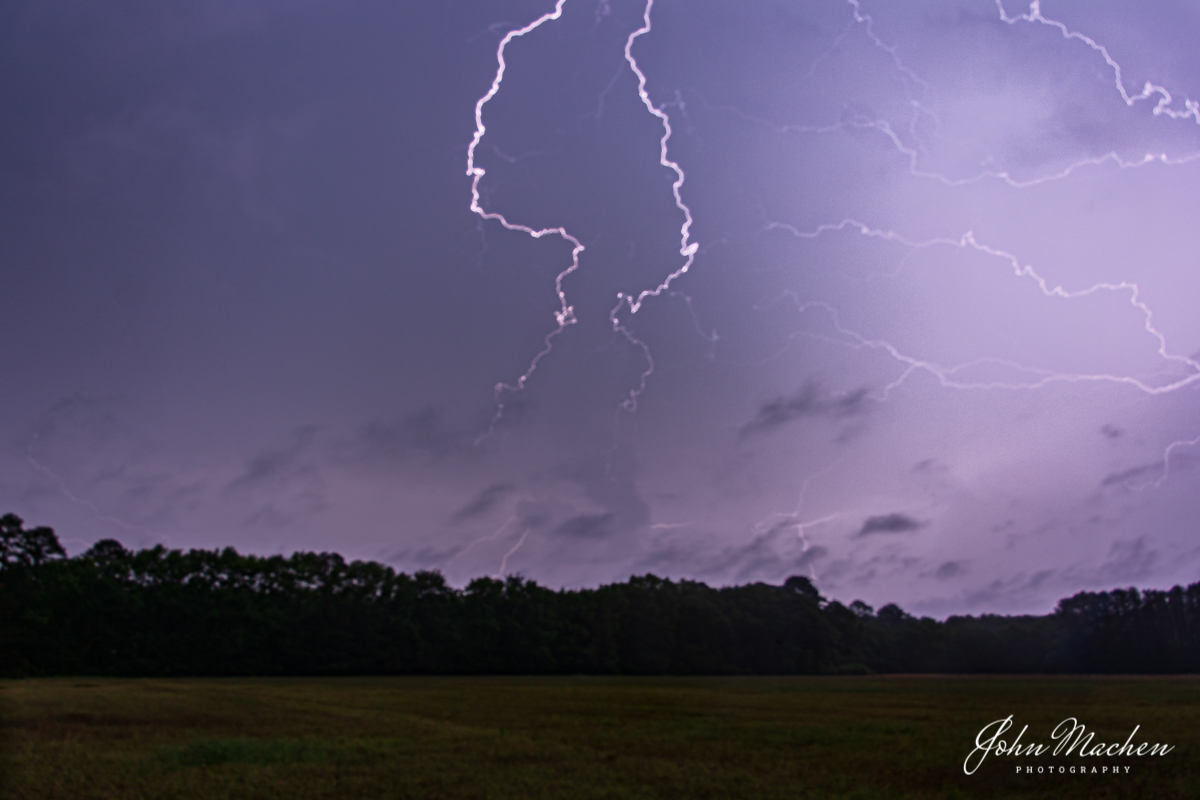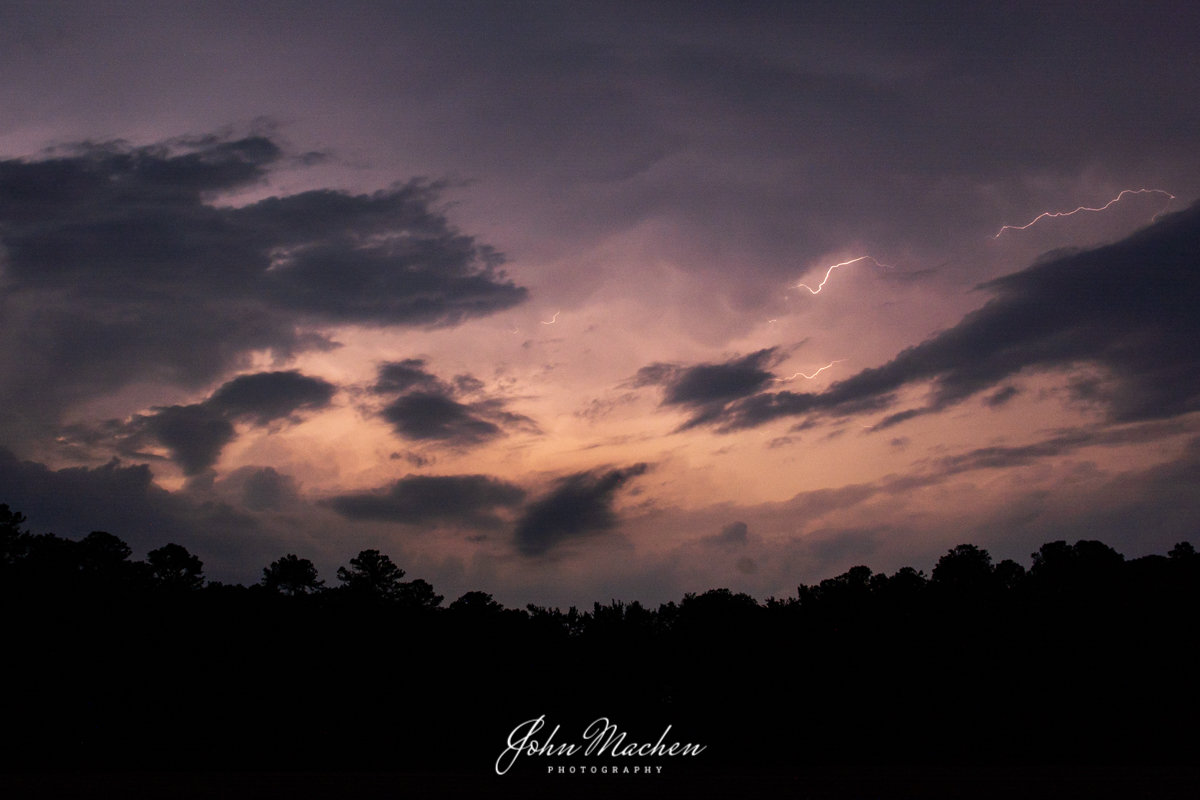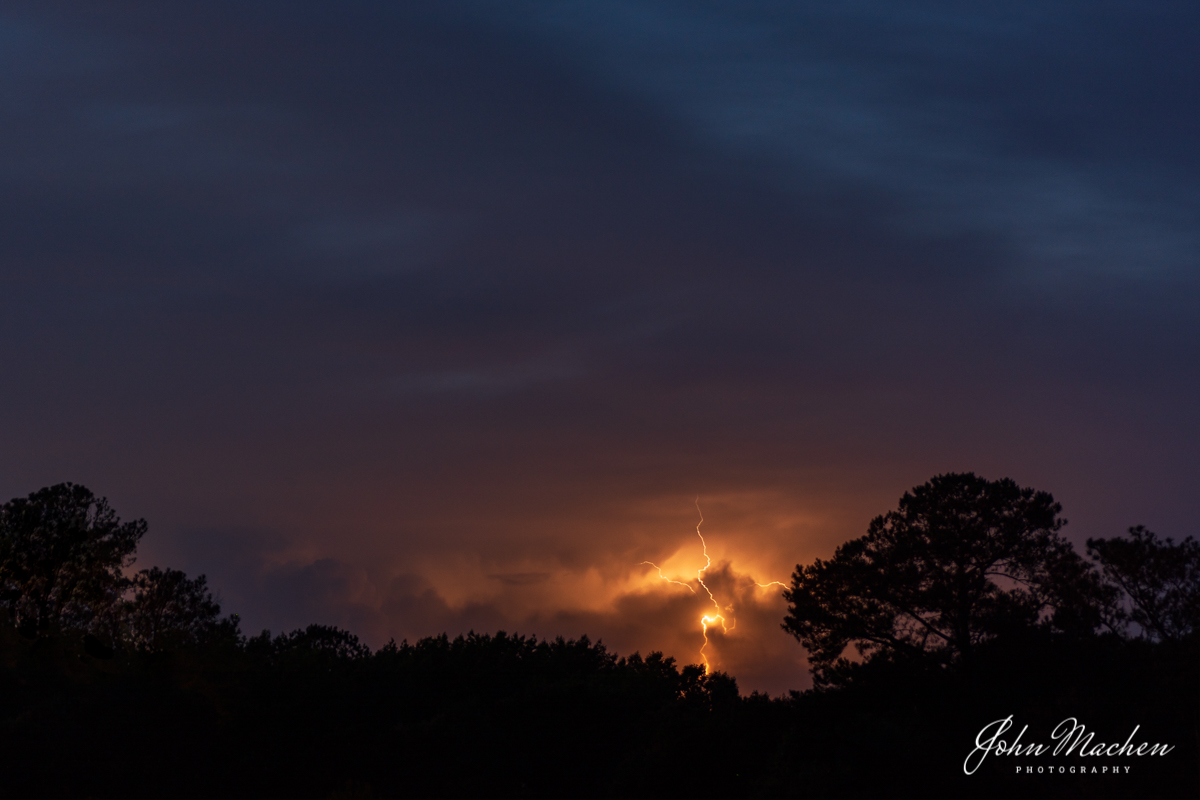A self-described country boy from a farming family on the coast of southern Virginia, John has been active on the Lenspiration forums since 2015 and a member on Lenspiration since 2018. When he has time for photography, his excursions tend to evidence his undeniable hard-work ethic, love for adventure, and complete disregard for unnecessary comforts. Motivated by a recent assignment, he challenged himself to learn a new genre of photography not many have the determination to pursue. Here's an account of his foray into new territory and some valuable tips he has learned along the way.
I squinted my eyes in the dark, trying to see through the drenching rain and gusting wind. I was getting soaked, but I didn’t notice. My heart raced as I watched the target get nearer and nearer. All was ready as I waited for the right moment, finger on the trigger. Suddenly it happened. Boom!! I was successful.
No, I’m not hunting deer at night in the rain this time. My “prey” was actually a thunderstorm that rolled in at 2:30 a.m., bringing with it something way less predictable than any animal I've ever hunted: lightning. And I was shooting it with a Nikon D7200 67mm barrel. 😉
It was my first successful picture of lightning! But it all started several weeks before.
When one of the latest photo assignments was launched, Lightning Landscapes, the idea fascinated me. Being someone who has always loved watching powerful storms, I was excited to learn how to photograph lightning! I’m also blessed to live in an area (eastern Virginia) where thunderstorms with lightning are at least possible, although not nearly as frequent as many mid-western states.
So after reading and watching several fantastic articles and videos, all I had to do was hurry up and wait for a thunderstorm to come through.
And, there were no thunderstorms nearby for a long time. But finally a month and a day later, the wait was over.
I quickly drove (at the speed limit😉) to a nearby field and watched as the storm approached. After taking a few pictures of the dark clouds, I set up my tripod and camera inside my truck with the window down. I then set my camera settings with as long of a shutter speed as possible while not over exposed, and turned on my camera’s built-in Interval Timer, the easiest way to capture lightning photos.
But soon the rain hit and I never saw any lightning across the field.
It was about a week later when I woke up in the middle of the night and realized there was another thunderstorm here. I grabbed my camera and tripod and dashed out to my truck again, and drove to another field where I’d be able to see a lot of sky facing the direction of the storm. Again I set up my camera inside the truck with the window down (to stay safe from lightning and keep my camera equipment more dry). But boy did I still get soaking wet!
But it was worth it! I finally got my first picture of lightning in that storm.
I was so excited!!! I could hardly go back to sleep later that night. But after looking at it again in the morning, I realized that the lightning wasn’t in focus. Apparently I’d forgotten to manually focus the lens to the correct distance.
But thankfully, I was blessed with another chance very soon after. That evening a distant approaching thunderstorm with seemingly constant flashes of lightning appeared on the horizon, but I decided to stay on the couch and read a book instead… Of course not! 😉
I hurried to a spot where I could photograph it, and since the storm was a safe distance away I set up my camera and tripod in the field next to my truck.
Then I settled in for a 45 minute light show!
I’d never seen a storm with more constant flashes of lightning! It seemed like several every second. But this storm only had cloud-to-cloud and intra-cloud lighting.
After about an hour, the storm was getting very close and I realized I’d better head back to shelter soon. The winds picked up and started blowing debris across the road as I drove back home. By the time I arrived, we’d already lost power!
I still hadn’t gotten any cloud-to-ground lightning photos yet, which is what I was hoping for all along. So I tried a few storms after that, but without success. But the truth is, I was hooked. Every storm is unlike any other one. The strength, power, beauty, and uniqueness displayed in so many storms is amazing! Which reminds me of the verse: Psalms 77:18 “The voice of thy thunder was in the heaven: the lightnings lightened the world: the earth trembled and shook.”
Then last Monday, I was busy most of the day but late that afternoon I noticed there might be some thunderstorms brewing in the area. Sure enough, there were. I finished what I was doing and now slightly familiar with the fast paced routine, headed out to photograph this thunderstorm. And boy was I in for a treat!
The storm I’d been chasing all along had finally arrived!
I couldn't use my 16-85mm wide-angle lens, because it was too bright to use a shutter speed slower than 1/15 of a second and the polarizing filters I had didn't fit my wide angle lens. So I pulled out my 35mm prime lens. Not ideal for wide angle situations, but it was the best option I had as I needed at least a two second exposure.
Cracked Sky
Tick Neck Rd., Mathews, Virginia
It was incredible! You can’t help but feel so small compared to such an amazing natural phenomenon.
Did you know lightning strikes the earth around 100 times a second? That's 8 million times per day or 3 billion times per year. Wow!!
Greased Lightning
Tick Neck Rd., Mathews, Virginia
Looking back, I can see how far I've come and how much I've learned! I'm so thankful to be able to see and share this example of God's glory in creation with others.
Here's a few things I've learned along the way that really helped me photograph lightning!
- Use a DSLR camera with a tripod. If you set it up and don’t move it during the storm, you can also stack the lightning bolts in Photoshop or create some amazing time lapses. You could also use a phone with video and stack individual frames into a single shot in post processing.
- The longer your shutter speed, the more chance of lightning striking while it’s open. Use at least a one or two second shutter speed. It’s a good idea to check and make sure you’re exposing correctly for the lightning. Also, be aware if the clouds are low and moving fast as they’ll be blurred and mushy if the shutter speed is too long. At night, you'll most likely be using 15-30 seconds shutter speed.
- Find some sort of shelter to photograph from. Not only is it significantly safer from lightning, but thunderstorms often carry a lot of rain. So if you’re in or under something, it will likely stay a lot more dry. Setting up the camera and tripod inside a vehicle with the window down works fine.
- When photographing lightning during daylight, using an ND filter or Polarizing filter helps to reduce light enough to use a multi-second shutter speed.
- One of the most important tips is to utilize your camera’s built-in Interval Timer. Simply set the right camera exposure first and then activate the Interval timer. It’ll start taking pictures continuously until you turn it off. It helps to use as fast of a memory card as you have.
- Manually focus the lens to where the lightning is sharp (likely somewhere just before infinity) and turn off auto-focus. If at night, focusing on a distant light works pretty well.
- Get some kind of severe weather radar app and keep it with you while you’re out photographing. You may need to find out how severe the storm is and what direction it's headed. RadarScope is what I use. It's a paid app, but totally worth it!
- Set up where you have a large view of the sky and frame your photos so that the sky occupies most of the frame. Face the direction the storm is coming from or wherever you see frequent lightning bolts. Try to find an interesting subject to include in the foreground or background. It's best to have a nice composition whether there's lightning in the shot or not.
- And lastly, (but DEFINITELY not least) be safe! Here's some safety tips a weather forecasting friend of mine (Andrew) put together for me:
- Lightning is deadly and deserves healthy respect. While it’s amazing to watch and photograph, it also can be incredibly dangerous. Remember that thunderstorms can also bring strong winds, hail, and occasionally tornadoes. When you’re working around storms, be weather aware—no picture is worth your safety!
- If you can hear thunder, you’re close enough to be struck by lightning, which can reach up to 15 miles from the parent thunderstorm. “When thunder roars, go indoors!”
- When working or playing (or taking pictures) around lightning, remember the 30 minute rule: stay inside a sturdy structure or vehicle until at least 30 minutes after the last thunder is heard.
- If you have to seek shelter (and pack the camera away), don’t worry: there will be other storms! Safety is always paramount. And, each storm is an opportunity to enjoy an amazing aspect of creation—whether that’s through the lens of a camera, the windshield of a truck, or the window of your house!
Later that night (after that last storm) a final thunderstorm passed by in the far distance. The fiery, orange cloud lightning was so incredible!
After reviewing the shots I had gotten, I just loved the next two photos!
Serpentine Eyes
Green Mansion Cove, Mathews, Virginia
The Cross
Green Mansion Cove, Mathews, Virginia




















Wow, amazing! Those are some phenomenal lightning strikes and storm clouds. Sounds like quite the adventure!
It has been quite the adventure! Thanks 🙂
I really admire your perseverance, bro! Honestly, I never thought I’d be seeing pictures like these! They’re stunning!!